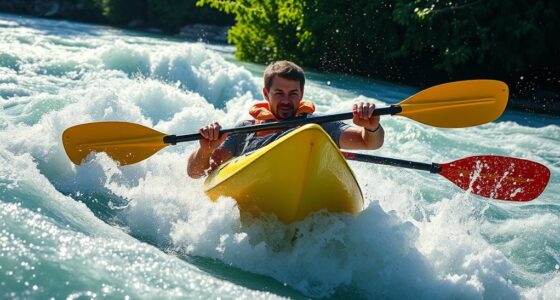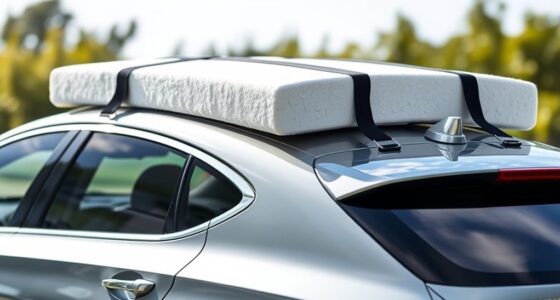To select the appropriate bilge pump for your coastal kayak, consider a pump with an adequate flow rate (GPH) that matches your boat size and potential water risks. Look for durable, corrosion-resistant materials suitable for saltwater. Confirm it’s easy to install with proper wiring and automatic float switches for reliable operation. Paying attention to these features helps keep your kayak dry and safe, and there’s more to learn about making the best selection for your needs.
Key Takeaways
- Choose a bilge pump with adequate GPH flow rate suitable for your kayak size and water risks.
- Select corrosion-resistant, marine-grade pumps to withstand saltwater exposure and ensure durability.
- Opt for automatic float switches for reliable, hands-free operation during water ingress.
- Ensure proper wiring with waterproof connectors and secure connections to prevent electrical failures.
- Follow manufacturer installation instructions or consult a marine electrician for safe, effective setup.

Choosing the right bilge pump is essential to keeping your boat safe and dry, especially in emergencies. When you’re out on the water, unexpected water ingress can happen quickly, and having a reliable pump ensures you can manage it before it becomes a serious problem. For coastal kayaks, selecting a bilge pump that suits your needs means considering both marine safety and the complexities of electrical wiring. You want a pump that can operate efficiently, is easy to install, and, most importantly, keeps you safe.
Choosing the right bilge pump ensures safety, efficiency, and peace of mind on your coastal kayak.
Marine safety is your top priority, so the pump you choose should be capable of handling the volume of water you might encounter. Coastal waters can be unpredictable, and heavy rain or waves can flood your kayak faster than you expect. Look for a pump with an adequate flow rate—measured in gallons per hour (GPH)—that matches the size of your kayak and the likelihood of water entering. A pump with a higher GPH rating provides a quicker response, reducing the risk of sinking or capsizing. Additionally, ensure the pump is durable and resistant to corrosion, as saltwater exposure can degrade inferior materials.
Electrical wiring plays a vital role in the effectiveness and safety of your bilge pump. Many pumps operate on 12V DC systems, so understanding your kayak’s electrical setup is crucial. You’ll need to check that your wiring can support the pump’s power requirements without overloading your system. Proper insulation and secure connections prevent short circuits, which could cause the pump to fail when you need it most. When installing, keep wiring away from sharp objects and moving parts to avoid damage. Using waterproof connectors and sealing any exposed wiring with marine-grade sealant further enhances safety and longevity. Selecting a pump with automatic float switches can also help ensure reliable operation under changing water conditions.
Selecting a bilge pump with a simple wiring setup makes your installation easier and reduces the risk of electrical issues. Consider models with built-in automatic float switches that activate when water reaches a certain level, so you don’t have to manually turn the pump on every time. These automatic features enhance marine safety by ensuring the pump responds promptly without your intervention. When wiring your pump, always follow manufacturer instructions, and if you’re unsure about electrical connections, consult a marine electrician. Proper wiring ensures your pump functions reliably, especially in critical moments when every second counts.
Frequently Asked Questions
How Often Should I Test My Bilge Pump During Trips?
During your trips, you should test your bilge pump regularly to verify it’s working properly. Follow a maintenance schedule that includes testing the pump at least once a day or whenever you start a new trip. Use simple testing procedures, like pouring water into the bilge area and activating the pump, to confirm it operates correctly. Consistent testing helps prevent unexpected failures and keeps you safe on the water.
Can I Manually Operate an Automatic Bilge Pump?
Did you know that automatic bilge pumps activate only when water reaches a certain level? Yes, you can manually operate an automatic bilge pump for emergency use, even if it’s designed to run automatically. Most models have a manual override or switch, allowing you to respond quickly during unexpected flooding. Keep in mind, manual operation is essential in emergencies when automatic features fail or water levels are low.
What Is the Lifespan of a Typical Bilge Pump?
A typical bilge pump lasts about 3 to 5 years, depending on usage and maintenance. You should regularly perform pump maintenance, checking for corrosion or debris, to extend its lifespan. Guaranteeing electrical compatibility with your kayak’s system is vital to prevent damage and ensure reliable operation. Proper maintenance and compatible wiring help your pump function efficiently, keeping your vessel safe and dry during your adventures.
Are There Eco-Friendly Bilge Pump Options Available?
Your quest for eco-friendly bilge pumps isn’t just a drop in the ocean—it’s a wave of change. Today, you can find models made from eco-friendly materials and biodegradable options that reduce environmental impact. These pumps are designed to be gentle on nature while still performing effectively. So, yes, eco-friendly bilge pump options are available, helping you keep your kayak and the planet safe with every pump.
How Do I Prevent Debris From Clogging My Bilge Pump?
To prevent debris from clogging your bilge pump, you should implement debris filtering by installing a fine mesh screen or filter around the intake. Regular pump maintenance is also essential; clean the filter and pump parts frequently, especially after trips. Check for debris buildup and clear it promptly. These steps keep your bilge pump functioning smoothly, ensuring reliable operation and reducing the risk of clogging during your kayaking adventures.
Conclusion
Choosing the right bilge pump is like finding the perfect paddle—essential for smooth sailing. When you pick a pump suited to your coastal kayak, you’re arming yourself against unexpected splashes and leaks. Think of it as a trustworthy friend that’s always there to keep your boat afloat and your adventure worry-free. With the right pump on board, you’ll navigate coastal waters with confidence, knowing you’re prepared to weather any splash or swell that comes your way.










